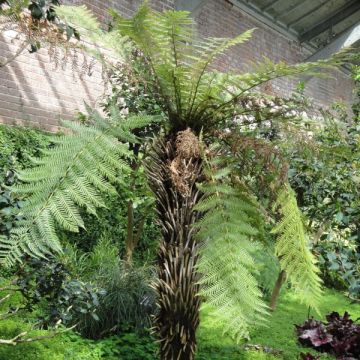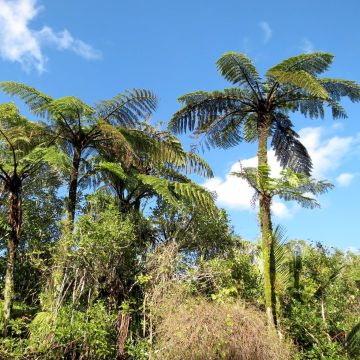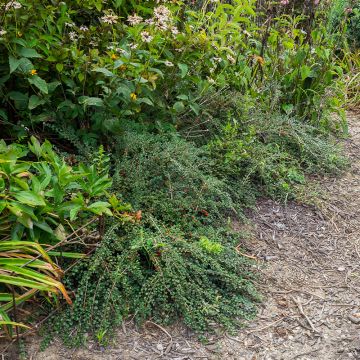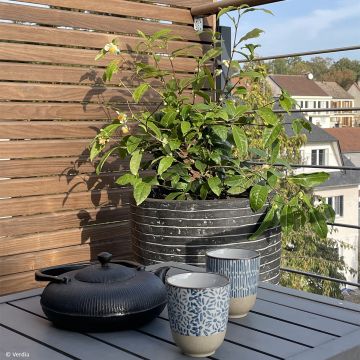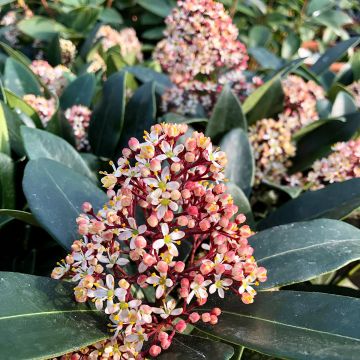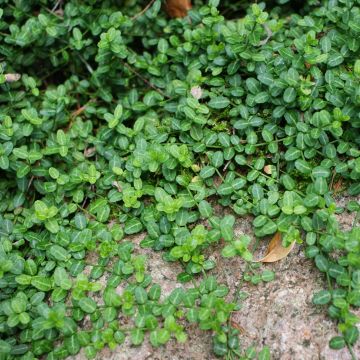

Cyathea dealbata - Silver Tree Fern
Cyathea dealbata - Silver Tree Fern
Cyathea dealbata
Silvery tree fern, Silver fern, Ponga, New Zealand Silver Fern
This item cannot be shipped to the selected country
Delivery charge from €5.90
More information
Schedule delivery date,
and select date in basket
This plant carries a 24 months recovery warranty
More information
We guarantee the quality of our plants for a full growing cycle, and will replace at our expense any plant that fails to recover under normal climatic and planting conditions.
From €5.90 for pickup delivery and €6.90 for home delivery
Express home delivery from €8.90.
Does this plant fit my garden?
Set up your Plantfit profile →
Description
Although less well-known than Cyathea cooperii, Cyathea dealbata is perhaps the most beautiful tree fern in New Zealand. This species is adorned with large fronds with silver undersides, hence its common name silver fern. The elegant plant has a dark false trunk (stipe) and carries an opulent crown of large fronds. This fern is so iconic that an image of its fronds has been chosen to adorn the official jersey of New Zealand's national rugby union team, the famous All Blacks. Being an exotic centrepiece in itself, it will suit a partially shaded terrace throughout the summer and will be a highlight in a shaded conservatory in winter. Cultivating this wonderful plant requires a certain expertise.
Cyathea dealbata belongs to the large Cyatheaceae family, whose members inhabit the humid tropical and subtropical regions of the Southern Hemisphere. It is a species of warm and humid temperate climate that can only withstand weak and brief frosts in sheltered situations. The fronds will burn at -4°C (24.8°F), and the trunk will not survive below -8°C (17.6°F). In nature, this fern needs a constant climate all year round, characterised by regular and significant rainfall and a temperature that varies seasonally by only 10 to 18°C (50 to 64.4°F), 15 to 20°C (59 to 68°F) or 18 to 25°C (64.4 to 77°F). It grows in partial shade, in cool, light, leached acid soils, that are poor in organic matter but rich enough in minerals.
The plant initially shows a rather slow growth, even in a warm temperate greenhouse. It develops a thick stipe (20 to 40cm (8 to 16in) in diameter) that can reach 4 to 5m (13 to 16ft) in height. This false trunk is made up of interlaced rhizomes covered with dry adventitious roots and the brown, scaly, papery remnants of the petioles of the old leaves. The base of the fronds is also covered with brown scales, giving them a coarse fur-like appearance. The petiole, on the other hand, is silver in colour. The young, rolled-up fronds, called croziers, are also scaly, and they unfold into large, finely divided, light green fronds measuring 2 to 3m (7 to 10ft) in length. The underside of the mature fronds (over 1 year old) is silver in colour. They are produced in the upper part of the stipe, one after the other, without interruption if the plant is kept above 10°C (50°F). Each one is traversed by a silver-coloured rachis. The fronds are evergreen and each has an average lifespan of 2 years when frosts are not too severe.
Tree ferns are not known for their great hardiness, and Cyathea dealbata is no exception. The best solution is to cultivate it in a large pot to be brought indoors in winter in a conservatory kept frost-free or very lightly heated. In addition to its low cold resistance, this tree fern only thrives in the shaded and humid atmosphere of an understory and in light, cool soil without any trace of limestone. Therefore, its cultivation in open ground is reserved for the mildest regions. It seems that mature plants appreciate the sun, which is very rare among ferns.
The Maoris used the fronds of the Silver Fern to find their way in the forest during moonlit nights. Like Hansel and Gretel, they placed its reversed leaves at regular intervals, as their silver scales reflect the light.
Report an error about the product description
Cyathea dealbata - Silver Tree Fern in pictures


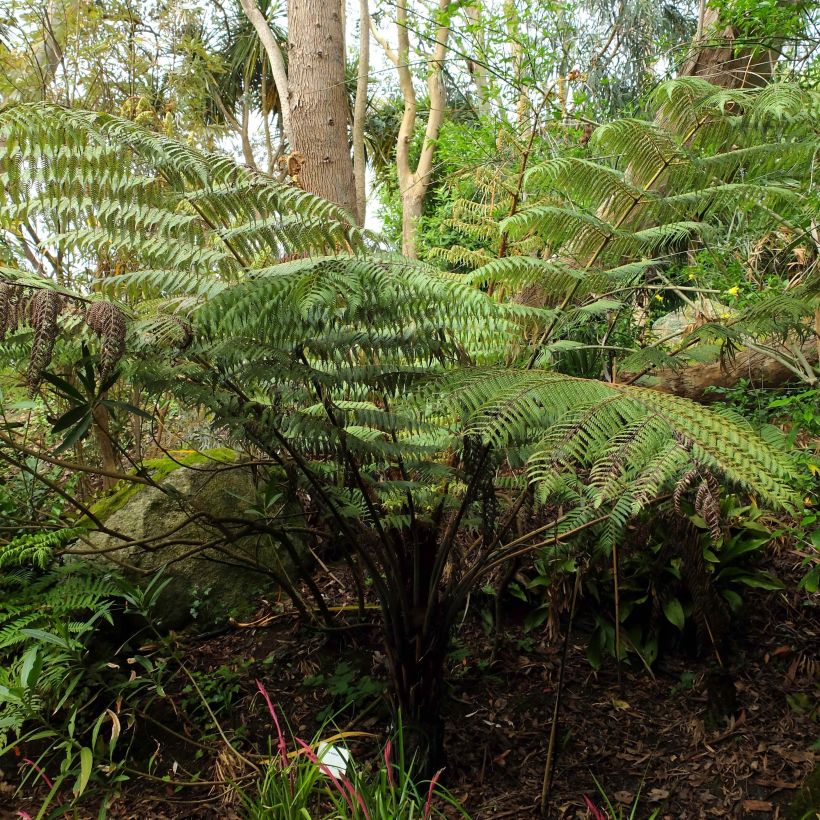

Plant habit
Foliage
Botanical data
Cyathea
dealbata
Cyatheaceae
Silvery tree fern, Silver fern, Ponga, New Zealand Silver Fern
Oceania
Other Tree Ferns
Planting and care
Cyathea dealbata grows in partial shade. It tolerates non-burning sun in a sheltered location with a humid atmosphere. The most important factor is the air humidity, which should be as high as possible as it is sensitive to drying winds. It prefers fresh, light, acidic soils without any traces of limestone and does not tolerate watering with hard water. Planting it in the ground is mainly suitable for mild oceanic climates (zone 9), otherwise it should be grown in a pot and brought indoors to a frost-free conservatory during winter. Tree ferns are not known for their high hardiness. Cyathea dealbata is hardy without protection down to approximately -6°C (21.2°F) for a very short period, if it is in a calm, windless location. Beyond that, winter protection is essential. This can be as simple as a "straw hat" to shelter the future fronds at the top of the trunk, which is the most sensitive area to cold. This way, the fern can withstand temperatures of around -5°C (23°F) for a short period.
Fertilising and watering: this tree fern responds well to the application of liquid fertiliser for green plants. Reduce the recommended dose by half in non-limestone water and water the centre of the plant once or twice a week between March and November. However, it reacts very poorly to organic fertilisers (derived from decomposed living matter, animal or plant, such as manure or compost) which can burn its roots and cause it to perish within a few days. The death of the plant is indicated by the symptom of drooping, limp leaves.
Planting period
Intended location
Care
This item has not been reviewed yet - be the first to leave a review about it.
Evergreen shrubs
Haven't found what you were looking for?
Hardiness is the lowest winter temperature a plant can endure without suffering serious damage or even dying. However, hardiness is affected by location (a sheltered area, such as a patio), protection (winter cover) and soil type (hardiness is improved by well-drained soil).

Photo Sharing Terms & Conditions
In order to encourage gardeners to interact and share their experiences, Promesse de fleurs offers various media enabling content to be uploaded onto its Site - in particular via the ‘Photo sharing’ module.
The User agrees to refrain from:
- Posting any content that is illegal, prejudicial, insulting, racist, inciteful to hatred, revisionist, contrary to public decency, that infringes on privacy or on the privacy rights of third parties, in particular the publicity rights of persons and goods, intellectual property rights, or the right to privacy.
- Submitting content on behalf of a third party;
- Impersonate the identity of a third party and/or publish any personal information about a third party;
In general, the User undertakes to refrain from any unethical behaviour.
All Content (in particular text, comments, files, images, photos, videos, creative works, etc.), which may be subject to property or intellectual property rights, image or other private rights, shall remain the property of the User, subject to the limited rights granted by the terms of the licence granted by Promesse de fleurs as stated below. Users are at liberty to publish or not to publish such Content on the Site, notably via the ‘Photo Sharing’ facility, and accept that this Content shall be made public and freely accessible, notably on the Internet.
Users further acknowledge, undertake to have ,and guarantee that they hold all necessary rights and permissions to publish such material on the Site, in particular with regard to the legislation in force pertaining to any privacy, property, intellectual property, image, or contractual rights, or rights of any other nature. By publishing such Content on the Site, Users acknowledge accepting full liability as publishers of the Content within the meaning of the law, and grant Promesse de fleurs, free of charge, an inclusive, worldwide licence for the said Content for the entire duration of its publication, including all reproduction, representation, up/downloading, displaying, performing, transmission, and storage rights.
Users also grant permission for their name to be linked to the Content and accept that this link may not always be made available.
By engaging in posting material, Users consent to their Content becoming automatically accessible on the Internet, in particular on other sites and/or blogs and/or web pages of the Promesse de fleurs site, including in particular social pages and the Promesse de fleurs catalogue.
Users may secure the removal of entrusted content free of charge by issuing a simple request via our contact form.
The flowering period indicated on our website applies to countries and regions located in USDA zone 8 (France, the United Kingdom, Ireland, the Netherlands, etc.)
It will vary according to where you live:
- In zones 9 to 10 (Italy, Spain, Greece, etc.), flowering will occur about 2 to 4 weeks earlier.
- In zones 6 to 7 (Germany, Poland, Slovenia, and lower mountainous regions), flowering will be delayed by 2 to 3 weeks.
- In zone 5 (Central Europe, Scandinavia), blooming will be delayed by 3 to 5 weeks.
In temperate climates, pruning of spring-flowering shrubs (forsythia, spireas, etc.) should be done just after flowering.
Pruning of summer-flowering shrubs (Indian Lilac, Perovskia, etc.) can be done in winter or spring.
In cold regions as well as with frost-sensitive plants, avoid pruning too early when severe frosts may still occur.
The planting period indicated on our website applies to countries and regions located in USDA zone 8 (France, United Kingdom, Ireland, Netherlands).
It will vary according to where you live:
- In Mediterranean zones (Marseille, Madrid, Milan, etc.), autumn and winter are the best planting periods.
- In continental zones (Strasbourg, Munich, Vienna, etc.), delay planting by 2 to 3 weeks in spring and bring it forward by 2 to 4 weeks in autumn.
- In mountainous regions (the Alps, Pyrenees, Carpathians, etc.), it is best to plant in late spring (May-June) or late summer (August-September).
The harvesting period indicated on our website applies to countries and regions in USDA zone 8 (France, England, Ireland, the Netherlands).
In colder areas (Scandinavia, Poland, Austria...) fruit and vegetable harvests are likely to be delayed by 3-4 weeks.
In warmer areas (Italy, Spain, Greece, etc.), harvesting will probably take place earlier, depending on weather conditions.
The sowing periods indicated on our website apply to countries and regions within USDA Zone 8 (France, UK, Ireland, Netherlands).
In colder areas (Scandinavia, Poland, Austria...), delay any outdoor sowing by 3-4 weeks, or sow under glass.
In warmer climes (Italy, Spain, Greece, etc.), bring outdoor sowing forward by a few weeks.


































